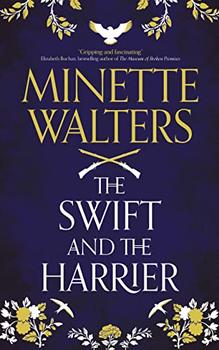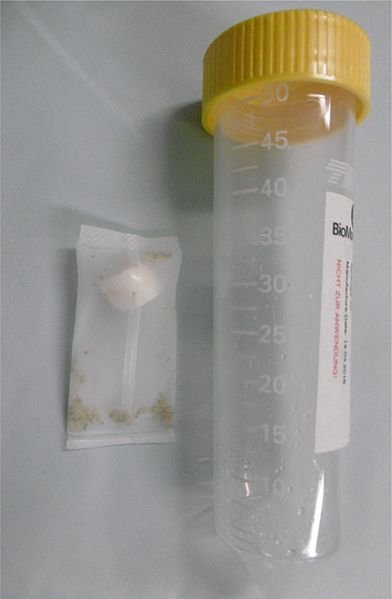Summary | Excerpt | Reviews | Beyond the Book | Read-Alikes | Genres & Themes | Author Bio

This article relates to The Swift and the Harrier
 For a novel that focuses on a physician during an incredibly bloody war, The Swift and the Harrier by Minette Walters is generally not too explicit in describing the treatment of wounds. The passage below is an exception; when main character Jayne's brother suffers a pike wound to the thigh that soon becomes infected, her mentor suggests what we now call larval therapy: the introduction of maggots to gangrenous wounds. While certainly gross enough to disgust most modern readers — and seemingly very far removed from our own times — larval therapy, which has existed in some form or another since antiquity (and still does), is a fascinating phenomenon and indicative in the above passage of a change sweeping European medicine in the 16th and 17th centuries.
For a novel that focuses on a physician during an incredibly bloody war, The Swift and the Harrier by Minette Walters is generally not too explicit in describing the treatment of wounds. The passage below is an exception; when main character Jayne's brother suffers a pike wound to the thigh that soon becomes infected, her mentor suggests what we now call larval therapy: the introduction of maggots to gangrenous wounds. While certainly gross enough to disgust most modern readers — and seemingly very far removed from our own times — larval therapy, which has existed in some form or another since antiquity (and still does), is a fascinating phenomenon and indicative in the above passage of a change sweeping European medicine in the 16th and 17th centuries.
"The sack contained a glass bell jar with a writhing mass of maggots in its base. Richard told Jayne he began experimenting with the creatures after reading a report from a French surgeon in the previous century who noticed that wounded soldiers infested with maggots seemed able to recover from gangrene of their own accord. There appeared to be no logic to it, and yet Richard's first experiment, on a man with a gangrenous foot, proved true."
In the most basic terms, larval therapy involves placing live maggots into a wound in order to clear out gangrenous material. The maggots only eat diseased flesh while leaving the healthy flesh alone. Especially in times before the advent of antibiotics, this was one of the best ways to debride and disinfect a wound. Larval therapy was often coupled with saline cleansing — in The Swift and the Harrier, physician Jayne recommends bathing in the sea to achieve a similar effect — and was an excellent way to avoid amputation. Larval therapy is still sometimes used today to treat chronically infected wounds and ulcers. In 2004, the FDA approved medicinal maggots as general surgery devices, and the treatment may be making a comeback.
One of the earliest mentions of larval therapy appears in the Old Testament. It was also recorded as a medical treatment by ancient Mayan, Aboriginal Australian and Myanmarese people. There is direct historical evidence for the context in which the cure appears in The Swift and the Harrier: The "French surgeon in the previous century" mentioned by Richard was likely the barber-surgeon Ambroise Paré, who served the French kings Charles IX and Henri III during the Wars of Religion (1562-1598). In addition to introducing this ancient form of medical treatment to his 16th-century patients, Paré improved methods of amputation. One of his greatest contributions to medicine was his promotion of empiricism, or medical practice founded on experience without the aid of previous theory. In other words, rather than accepting age-old concepts like the four humors or the idea that certain mental illnesses were caused by evil spirits inside a person's body, Paré trusted what he had experienced as a medical professional. If a treatment — no matter how unorthodox — worked, Paré would continue using that treatment on other patients.
Someone who followed in his footsteps — and who is named in The Swift and the Harrier — is Thomas Sydenham, a doctor referred to as "the English Hippocrates" and a man responsible for bringing many new developments to 17th century English medicine. In the novel, he appears as a young medical student who must briefly abandon his studies to fight on behalf of the Parliamentarians. Through his empiricist interests and commitment to diagnosing disease before treating it, Walters makes Sydenham's burgeoning genius clear, even if some of his preferred methods — namely larval theory — may make us recoil today.
Maggots in BioBag for larvae therapy, photo by Enter (CC BY-SA 4.0)
Filed under Medicine, Science and Tech
![]() This "beyond the book article" relates to The Swift and the Harrier. It originally ran in September 2022 and has been updated for the
July 2023 paperback edition.
Go to magazine.
This "beyond the book article" relates to The Swift and the Harrier. It originally ran in September 2022 and has been updated for the
July 2023 paperback edition.
Go to magazine.
Heaven has no rage like love to hatred turned, Nor hell a fury like a woman scorned.
Click Here to find out who said this, as well as discovering other famous literary quotes!
Your guide toexceptional books
BookBrowse seeks out and recommends the best in contemporary fiction and nonfiction—books that not only engage and entertain but also deepen our understanding of ourselves and the world around us.